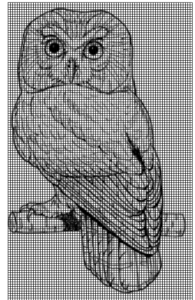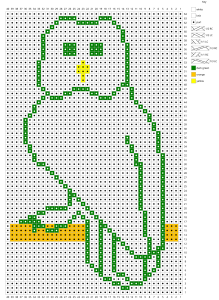I’m continuing a blog challenge to myself to demonstrate the process of developing realistic motifs in several different techniques. Let’s make some exuberant beauty!
My process of making a knitted motif. First, the drawing (with copyright in the comfy place)
Glancing through my copy of Bird Illustrations CD-ROM and book, I decided that I wanted to work with the Northern Saw Whet Owl, originally from Birds of Prey Coloring Book, John Green, copyright © 1989 by John Green.
 Second scout out trouble spots: the perch is horizontal, the edge of the upper feathers in the wings is horizontal too. But the feathered circles around the eyes dip and curve helpfully.
Second scout out trouble spots: the perch is horizontal, the edge of the upper feathers in the wings is horizontal too. But the feathered circles around the eyes dip and curve helpfully.
The first technique I’m trying in this series is: sculptural knitting from the Kathleen Warnick article One-color Picture Knitting article in Threads Magazine April/May1990.
I plan to use the heavy outline as the twist stitches, then fill in the lighter textures with knit/purl stitches. The eyes will probably be baubles, or flat baubles. I’ll try a bunch or things for the beak and claws. For the perch, I’m thinking a section of stockinette worked proud of the background, then re-connected to the body as a tube – Oh wait, that’s a bit high relief for a twist stitch chart, how about a 1/1 rib rectangle on a reverse stockinette ground, I’ll save the stockinette tube for the ring cable version. Uh-oh, the claw sits on top of it, tricky.

The next step is to make an overlay of a grid, then use that as a base for a knitting grid. I find that a square grid is a good start, because the twist stitches draw in the horizontal part of the knitting – knitter’s graph paper is important for color work though, where the natural brick shapes of stockinette really show.

Once I have a knitting chart, I can knit it.
Dun Dun Dun. Then the truth will out – sort of.
Actually (less catestrophically) then the editing can start. Usually I need about 12 iterations.
But now, I think my initial color chart is a bit inaccurate, and I’d better go tweak it.
